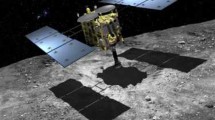Abstract
Aiming at the reality of different potential differences on the surface of a spacecraft, it is very difficult to obtain a potential difference in the laboratory. In order to disclose the influence of potential difference on discharge, we have segmented a spacecraft surface into different parts with reserved gaps, in which gaps reserved in two adjacent surfaces are added resistances to create a multi-surface with different potential differences, and the low-potential surface as a, impact target in the split targets. In order to disclose the discharge characteristics, it is very vital to establish the charging and discharge systems. Therefore, a circuit system with different potential differences, discharge testing system, and ultra-high speed camera acquisition system are established by ourselves, and combining with a two-stage light gas gun loading system, nine sets of experiments have been conducted about hypervelocity impact on a 2A12 aluminum target with different potential differences. In experiments, gaps of a 2A12 aluminum target are the same among different potential parts in every experiments the gaps are 2 mm, 5 mm and 10 mm and applied voltages are 300 V, 200 V, and 100 V in every group experiment, respectively. The experiments have been performed at the impact velocity of about 3 km/s and the incidence angle of \(60^{\circ }\) (between projectile flying trajectory and target plane). Voltage and current probes are adopted to acquire discharge voltage and current during the process of impact. The experimental results show that the discharge induced by impact plasma is produced among high- and low-potential targets, the gaps with 2 mm, 5 mm, and 10 mm can evoke a primary discharge among different split targets, and a primary discharge current peak and discharge duration increase with the increase of the applied voltage at the same gap of split targets. Meanwhile, a secondary discharge is induced at the conditions of the gap for 2 mm and corresponding applied voltage of 200 V as well as 5 mm and 300 V, respectively.
















Similar content being viewed by others
References
Crawford, D.A.: The production and evolution of plasma associated magnetic fields during hypervelocity impacts: implications for planetary paleomagnetism, Ph.D. thesis, Brown University, pp. 32–73 (1992)
Smith, R.E.: Natural Orbital Environment guidelines for use in aerospace vehicle development, NASA TM-4527 (1994)
Tang, E.L., Zhang, Q.M., Zhang, J.: Preliminary study on magnetic induction intensity induced by plasma during hypervelocity impact. Chin. J. Aeronaut. 21(8), 387–392 (2009)
Drolshagen, G.: Hypervelocity impact effects on spacecraft, ESA/ESTEC, NL-2200AG Noordwijk, The Netherlands
Quintana, S.N., Crawford, D.A., Schultz, P.H.: Analysis of impact melt and vapor production in CTH for planetary applications. Procedia Eng. 103, 499–506 (2015)
Ecoffet, R.: Overview of in-orbit radiation induced spacecraft anomalies. IEEE Trans. Nucl. Sci. 60, 1791–1815 (2013)
Inguimbert, C., Bourdarie, S., Falguere, D., et al.: Anomalies of the ADSP 21060 onboard the DEMETER satellite. IEEE Trans. Nucl. Sci. 60, 4067–4073 (2013)
Huang, J.G., Han, J.W.: Analysis of a typical internal charging induced spacecraft anomaly. Acta Phys. Sinica 59(7), 2907–2912 (2010)
Ryden, K.A., Morris, P.A., Rodgers, D.J. et al.: Improved demonstration of internal charging hazard using realistic electron environment facility (REEF). In: 8th Spacecraft Charging Technology Conference, Huntsville, pp. 20–24 (2003)
Lai, S.T.: Electrostatic charging of mirrors in space: a plausible cause of solar panel anomalies on satellites. In: 18th Space Photovoltaic Research and Technology (SPRAT) Conference, Cleveland, Ohio, September 16–18 (2003)
Wang, R.Z., Tang, E.L., Han, Y.F., et al.: Electrostatic discharge of plasma created by hypervelocity impact 2A12 aluminum targets with gradient potential. IEEE Trans. Plasma Sci. 45(10), 2865–2874 (2017)
Tang, E.L., Li, Z.B., Zhang, Q.M., et al.: Experimental research on light flash generated by high-velocity impact on solar array. Int. J. Appl. Electromagn. Mech. 54, 569–581 (2017)
Acknowledgements
The authors would like to acknowledge National Natural Science Foundation of china (Grant No. 11472178), Open Foundation of Hypervelocity Impact Research Center of CARDC(Grant No. 20190201) and Open Project of State Key Laboratory of Explosion Science and technology in Beijing Institute of Technology (Grant No. KFJJ18-04M) to provide fund for conducting experiments.
Author information
Authors and Affiliations
Corresponding author
Additional information
Publisher's Note
Springer Nature remains neutral with regard to jurisdictional claims in published maps and institutional affiliations.
Rights and permissions
About this article
Cite this article
Tang, E., Wang, J. & Han, Y. Experimental research on discharge characteristics induced by hypervelocity impact on split targets with potential gradient. Acta Mech 230, 3525–3542 (2019). https://doi.org/10.1007/s00707-019-02483-y
Received:
Published:
Issue Date:
DOI: https://doi.org/10.1007/s00707-019-02483-y




